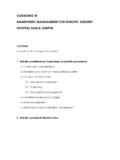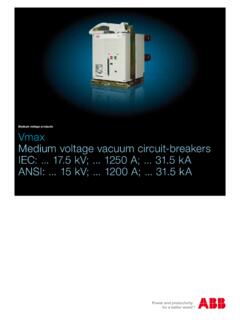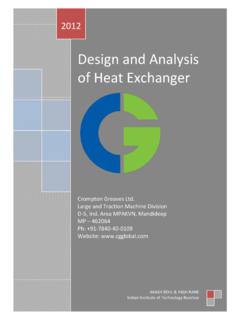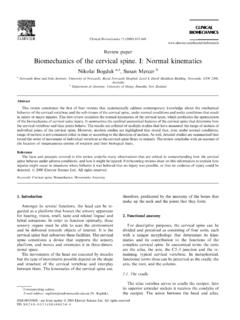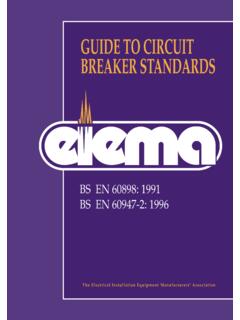Transcription of Training Report on 220 to 132kV Substation
1 Abhishek Dave | CTAE, UDAIPUR 1 A Report ON SUMMER Training Undertaken at 220/132 kV Substation at Bhinmal (Jalore) Under the guidance of Er. K. C. Gupta (executive engineer, 220KV GSS, Bhinmal) Er. Mathur (assistant engineer, 220KV GSS, Bhinmal) Er. Begad (junior engineer, 220KV GSS, Bhinmal) Submitted by: Abhishek Dave 2nd year, Electrical Engineering, College of Technology and Engineering, Udaipur Abhishek Dave | CTAE, UDAIPUR 2 Abhishek Dave | CTAE, UDAIPUR 3 Contents 1. 220/132 KV SUB- station Definition Introduction o About the Substation construction Site Selection & Layout Equipment in a 220KV Substation o Bus-bar o Insulators o Isolating Switches o Circuit breaker o Protective relay o Instrument Transformer Current Transformer Voltage Transformer o Metering and Indicating Instrument o Miscellaneous equipment o Transformer o Lightening arrestors o line isolator o Wave trap Single line diagram (SLD) Brief descriptions of the instruments in the line diagram are Abhishek Dave | CTAE, UDAIPUR 4 of sub- station :- The assembly of apparatus used to change some characteristics ( Voltage ac to dc freq.)
2 Etc) of electric supply is called sub- station :- The present day electrical power system is electric power is generated, transmitted and distributed in the form of Alternating current. The electric power is produce at the power station , which are located at favorable places, generally quite away from the consumers. It is delivered to the consumer through a large network of transmission and distribution. At many place in the line of power system, it may be desirable and necessary to change some characteristic ( Voltage, ac to dc, frequency etc.) of electric supply. This is accomplished by suitable apparatus called sub- station for example, generation voltage (11KV or ) at the power station is stepped up to high voltage (Say 220KV to 132kV ) for transmission of electric power.
3 Similarly near the consumer s localities, the voltage may have to be stepped down to utilization level. This job is again accomplished by suitable apparatus called sub- station . About the Substation :- The Substation in Bhinmal, Jalore-343029, Rajasthan is one of the largest power grids in the state of Rajasthan and the north-west area India. The most important of any Substation is the grounding (Earthing System) of the instruments, transformers etc. used in the Substation for the safety of the operation personnel as well as for proper system operation and performance of the protective devices. An earthes system comprising of an earthing mat buried at a suitable depth below ground and supplemented with ground rods at suitable points is provided in the substations . These ground the extra high voltage to the ground. As it is dangerous to us to go near the instrument without proper earth.
4 If the instruments are not ground properly they may give a huge shock to anyone who would stay near it and also it is dangerous for the costly instrument as they may get damaged by this high voltage. Site Selection & Layout 220KV Substation :- 220KV Sub- station forms an important link between Transmission network and Distribution network. It has a vital influence of reliability of service. Apart from ensuring efficient transmission and Distribution of power, the sub- station configuration should be such that it enables easy maintenance of equipment and minimum interruptions in power supply. Sub- station is constructed Abhishek Dave | CTAE, UDAIPUR 5 as near as possible to the load center. The voltage level of power transmission is decided on the quantum of power to be transmitted to the load center. Selection of site :- Main points to be considered while selecting the site for Grid Sub- station are as follows: i) The site chosen should be as near to the load center as possible.
5 Ii) It should be easily approachable by road or rail for transportation of equipments. iii) Land should be fairly leveled to minimize development cost. iv) Source of water should be as near to the site as possible. This is because water is required for various construction activities (especially civil works), earthing and for drinking purposes etc. v) The sub- station site should be as near to the town / city but should be clear of public places, aerodromes, and Military / police installations. vi) The land should be have sufficient ground area to accommodate Substation equipments, buildings, staff quarters, space for storage of material, such as store yards and store sheds etc. with roads and space for future expansion. vii) Set back distances from various roads such as National Highways, State Highways should be observed as per the regulations in force.
6 Viii) While selecting the land for the Substation preference to be given to the Govt. land over private land. ix) The land should not have water logging problem. x) Far away from obstructions, to permit easy and safe approach /termination of high voltage overhead transmission lines. in a 220KV Sub- station :- The equipment required for a transformer Sub- station depends upon the type of Sub- station , Service requirement and the degree of protection desired. 220KV EHV Sub- station has the following major equipments. 1) Bus-bar :- When a no. of lines operating at the same voltage have to be directly connected electrically, bus-bar are used, it is made up of copper or aluminum bars (generally of rectangular X-Section) and operate at constant voltage. The bus is a line in which the incoming feeders come into and get into the instruments for further step up or step down.
7 The first bus is used for putting the incoming feeders in LA single may be double line in the bus so that if any fault occurs in the one the other can still have the current and the supply will not stop. The two lines in the bus are separated by a little distance by a Conductor having a connector between them. This is so that one can work at a time and the other works only if the first is having any fault. Abhishek Dave | CTAE, UDAIPUR 6 2) Insulators :- The insulator serves two purpose. They support the conductor (or bus bar) and confine the current to the conductor. The most commonly used material for the manufactures of insulators is porcelain. There are several type of insulator ( pine type, suspension type etc.) and there used in Sub- station will depend upon the service requirement.
8 3) Isolating Switches :- In Sub- station , it is often desired to disconnect a part of the system for general maintenance and repairs. This is accomplished by an isolating switch or isolator. An isolator is essentially a kniff Switch and is design to often open a circuit under no load, in other words, isolator Switches are operate only when the line is which they are connected carry no load. For example, consider that the isolator are connected on both side of a cut breaker, if the isolators are to be opened, the must be opened first. 4) Circuit breaker :- A circuit breaker is an equipment, which can open or close a circuit under normal as well as fault condition. These circuit breaker breaks for a fault which can damage other instrument in the station . It is so designed that it can be operated manually (or by remote control) under normal conditions and automatically under fault condition.
9 There are mainly two types of circuit breakers used for any substations . They are (a) SF6 circuit breakers; (b) spring circuit breakers. For the latter operation a relay wt. is used with a generally bulk oil are used for voltage upto 66 KV while for high voltage low oil & SF6 are used. For still higher voltage, air blast vacuum or SF6 cut breaker are used. The use of SF6 circuit breaker is mainly in the substations which are having high input kv input, say above 220kv and more. The gas is put inside the circuit breaker by force ie under high pressure. When if the gas gets decreases there is a motor connected to the circuit breaker. The motor starts operating if the gas went lower than bar. There is a meter connected to the breaker so that it can be manually seen if the gas goes low. The circuit breaker uses the SF6 gas to reduce the torque produce in it due to any fault in the line .
10 The circuit breaker has a direct link with the instruments in the station , when any fault occur alarm bell rings. 5) Protective relay :- A protective relay is a device that detects the fault and initiates the operation of the to isolate the defective element from the rest of the system . The relay detects the abnormal condition in the electrical circuit by constantly measuring the electrical quantities, which are different under normal and fault condition. The electrical quantities which may change under fault condition are voltage, current, frequency and phase angle. Having detect the fault, the relay operate to close the trip circuit of Abhishek Dave | CTAE, UDAIPUR 7 6) Instrument Transformer :- The line in Sub- station operate at high voltage and carry current of thousands of amperes.
